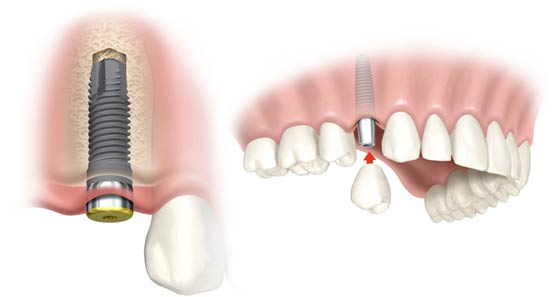How do Implants Work?
Implants have been the single most significant advance in dentistry in the last half century. They have made what was once impossible routine and have improved the oral condition of millions of patients. So, how do they do what they do?
- Implants are designed to help replace teeth that have been removed due to damage to the tooth, because of gum disease or because the tooth never came in.
- They can be used to replace a single tooth, to replace an entire set of teeth or to help secure a removable denture.
- Implant restorations have three separate parts, the implant, the abutment and the crown or denture.
What is an implant made of?
A traditional implant is a post made out of Class III Titanium metal, a material that has been used medically in human patients for about 50 years to repair or replace damaged bones. Implants have been used in dental applications for just about as long. The implant is coated in a way that causes the bone around it to fuse with the metal. When the fusion is complete, the implant becomes one with the surrounding bone and that bond is almost always permanent. For dental implants, integration takes between 2 and 6 months, depending on the type and health of the bone.
What happens after an implant heals?
Once the implant has healed to the bone, an abutment is fabricated. The implant is placed below the gums; the abutment screws into the implant and comes up out of the gums. It is onto the abutment that the final restoration is attached.
What does it look like in the end?
The final restoration could be a crown replacing a single tooth, a bridge that could replace several teeth, a fixed denture hybrid (All-on-4) that replaces all the upper or lower teeth or a removable denture. The abutment and final restoration generally take about 2-3 weeks to complete with the exception of the fixed hybrid denture, which takes 3-6 months to complete.
Are implants safe?
Implant restorations have become both routine and the standard of care. They are predicable, versatile and durable. They reverse the effects of time by adding new bone in the areas where they are placed. They relieve pressure on surrounding teeth or, more importantly, on adjacent gum and bones. They allow a non-removable option in situations where, prior to the use of implants, a removable denture was the only option available. They help secure removable dentures that were before a hopeless mess. Nearly anything at all in connection with tooth replacement is possible with the use of implants. They have made modern dentistry a golden age of possibilities.
Call (949) 770-3294
and schedule you Free Consultation today.
Or complete the form and
we will contact you.
Get a permanent solution and smile with confidence.






